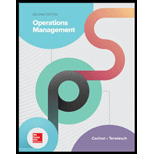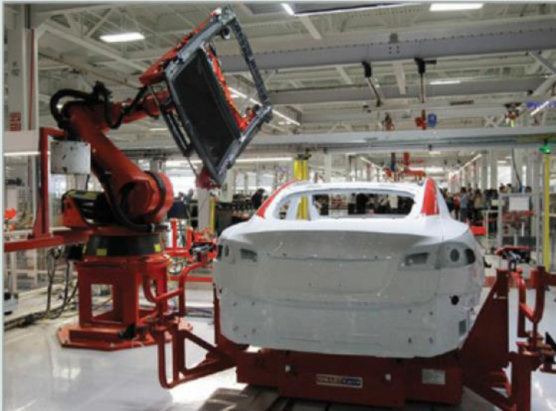
Concept explainers
The Tesla Model S, one of the most sought-after luxury cars, is produced in Tesla’s Freemont factory in California. The production process can be broken up into the following subprocesses.
Stamping: In the stamping process, coils of aluminum are unwound, cut into level pieces of sheet metal, and then inserted into stamping presses that shape the metal according to the geometry of the Model S. The presses can shape a sheet of metal in roughly 6 seconds.
Subassembly: The various pieces of metal are put together using a combination of joining techniques, including welding and adhesion. This creates the body of the vehicle.
Paint: The body of the vehicle is then moved to the paint shop. After painting is completed, the body moves through a 350° oven to cure the paint, followed by a sanding operation that ensures a clean surface.
General assembly: After painting, the vehicle body is moved to the final assembly area. Here, assembly workers and assembly robots insert the various subassemblies, such as the wiring, the dash board, the power train and the motor, the battery pack, and the seats.
Quality testing: Before being shipped to the customer, the now-assembled car is tested for its quality. It is driven on a rolling road, a test station that is basically a treadmill for cars that mimics driving on real streets.
Overall, the process is equipped with 160 robots and 3000 employees. The process produces some 500 vehicles each week. It takes a car about 3–5 days to move from the beginning of the process to the end.

Imagine you could take a tour of the Tesla plant. To prepare for this tour, draw a simple process flow diagram of the operation.
What is the cycle time of the process (assume two shifts of 8 hours each and 5 days a week of operation)?
Want to see the full answer?
Check out a sample textbook solution
Chapter 3 Solutions
Operations Management
Additional Business Textbook Solutions
Fundamentals of Financial Accounting
Principles of Operations Management: Sustainability and Supply Chain Management (10th Edition)
Engineering Economy (17th Edition)
Operations Management: Processes and Supply Chains (12th Edition) (What's New in Operations Management)
Horngren's Cost Accounting: A Managerial Emphasis (16th Edition)
Horngren's Accounting (12th Edition)
- Read the project statement and answer ALL of the questions that follow PROJECT STATEMENT The African Integrated High-Speed Railway Network (AIHSRN). African nations are preparing to invest billions in a significant overhaul of their rail infrastructure as part of an ambitious plan for the continent. One of the key projects underway is the African Integrated High-Speed Railway Network (AIHSRN), which aims to connect Africa's capital cities and major commercial centres with a high-speed railway network to enhance continental trade and competition. This network will span 2,000 km (1,243 miles) and connect 60 cities, including Nairobi, Lagos, Cairo, and Dakar. It will improve access to essential markets, enhance economic cooperation, and encourage regional collaboration. The plan is poised to revolutionise intra-African trade by reducing travel times and lowering transportation costs, making trade between African nations more competitive. The trains will be capable of reaching speeds of up…arrow_forwardIn the Sally Soprano case, Sally's agent prepares the potential issues to be discussed before the negotiation. Which items) may be on the list? Sally's salary and publicity Work-related benefits and incentives such as a hotel suite accommodation, limousine transportation, flower arrangements in the dressing room Future contracts and collaboration Rehearsal setup and arrangements All of the choicesarrow_forwardSummarize chapters 1 through 8 of the book "food and beverage cost control"arrow_forward
- Can you guys help me with this? Thank you! Here's the question: Compared to the CONSTRAINT model, how has the network changed? How do you plan to add contingency to your network? Please answer this thoroughly Here's the what-if scenario: Assume that the LA warehouse becomes temporarily or even indefinitely disabled since facing a large-scale labor disruption. Re-optimize the network considering this new constraint. Here's the scenario comparison analysis: Scenario Constraint Scenario vs What-if Scenario Summary The Constraint Scenario exhibits a higher total cost of $7,424,575.45 compared to the What-if Scenario's total cost of $6,611,905.60, signifying a difference of approximately $812,669.85, which indicates a more expensive operation in the Constraint Scenario. The average service time is slightly higher in the Constraint Scenario (0.72 days vs. 0.70 days), suggesting that the What-if Scenario provides a marginally quicker service. Moreover, the average end-to-end service time…arrow_forwardCan you guys help me with this? Thank you! Here's the question: Compared to the CONSTRAINT model, how has the network changed? How do you plan to add contingency to your network? Please answer this throughly Here's the what-if scenario: Assume that Dallas plant has lost power. It cannot serve the DCs anymore and has to remain locked indefinitely. Re-optimize the network considering this new constraint. Here's the scenario comparison analysis: Scenario Constraint Scenario vs What-if Scenario Summary In comparing the Constraint Scenario to the What-if Scenario, a few key differences highlight the efficiencies evident in the supply chain. Firstly, the total cost in the Constraint Scenario is lower at $7,424,575.45, while the What-if Scenario incurs a total cost of $7,486,369.12, resulting in a cost delta of $61,793.67. Additionally, although both scenarios exhibit the same average service time of 0.72 days, the What-if Scenario has a more favorable average end-to-end service time of 2.41…arrow_forwardEmployee In-Service Training ASSIGNMENT: In-Service Training. The intern is required to plan and implement two in-service training sessions for employees. Each in-service should last at least 10 but not more than 30 minutes and should be given to all employees affected. The preceptor or supervisor/unit manager must approve all in-service topics. 1) One presentation should be related to a policy or procedure of any kind (e.g. proper use of equipment); 2) The second presentation must be related to sanitation or safety. For each in-service presentation, the intern must develop a written class plan and a visual aid (may be a handout, poster, PowerPoint slide presentation, etc.) appropriate to the life experiences, cultural diversity and educational background of the target audience. The intern must also measure behavior change. Note, this cannot be measured by a written pre- and post- test. That would be measuring knowledge. The intern mustactually observe and document that the learners…arrow_forward
 Practical Management ScienceOperations ManagementISBN:9781337406659Author:WINSTON, Wayne L.Publisher:Cengage,
Practical Management ScienceOperations ManagementISBN:9781337406659Author:WINSTON, Wayne L.Publisher:Cengage, Contemporary MarketingMarketingISBN:9780357033777Author:Louis E. Boone, David L. KurtzPublisher:Cengage Learning
Contemporary MarketingMarketingISBN:9780357033777Author:Louis E. Boone, David L. KurtzPublisher:Cengage Learning

